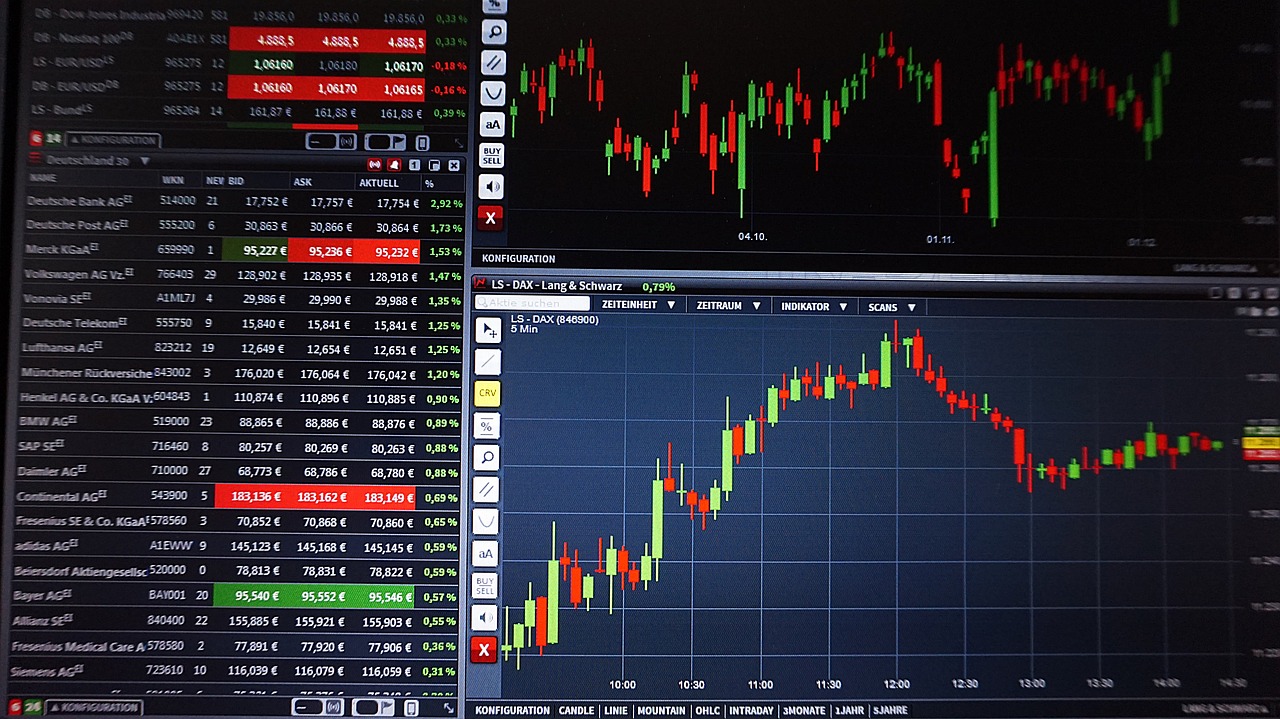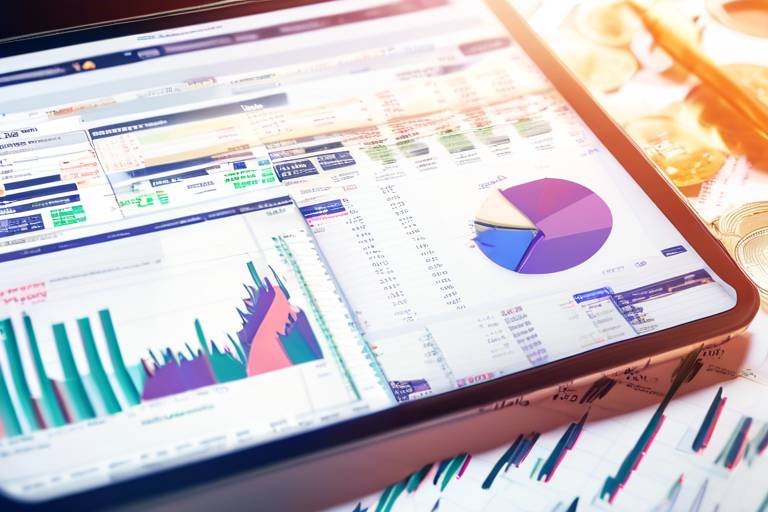Psychological Traps to Avoid in Trading
Trading is not just about numbers and charts; it's a complex dance of psychology that can make or break your success in the market. As traders, we often find ourselves battling not only market volatility but also our own minds. Understanding the psychological traps that can ensnare us is crucial for making informed decisions and enhancing our trading performance. In this article, we will explore some of the most common psychological pitfalls traders face, how to identify them, and strategies to avoid them. By being aware of these traps, you can cultivate a more disciplined and effective trading strategy that keeps you focused on your goals and minimizes costly mistakes.
Have you ever felt invincible after a string of successful trades? That’s the overconfidence bias in action! This psychological trap can lead traders to underestimate risks, which often results in poor decision-making. When you believe you have the market figured out, you might ignore vital indicators or dismiss the potential for loss. It’s essential to recognize the roots of this bias; perhaps it stems from past successes or a natural inclination to trust your instincts. To maintain a balanced perspective, consider implementing a check-and-balance system where you regularly review your trades and decisions with a critical eye. Ask yourself: “Am I being realistic about what I know?”
Loss aversion is a fascinating yet detrimental aspect of trading psychology. It refers to our tendency to prefer avoiding losses over acquiring equivalent gains. For instance, you might hold onto a losing position far too long, hoping for a rebound simply because the thought of realizing a loss feels unbearable. This trap can hinder effective trading strategies and lead to missed opportunities. To combat loss aversion, adopt a mindset shift: view losses as part of the trading process rather than failures. By reframing your perspective, you can better accept losses and move forward with your strategy.
Emotions can be a trader's worst enemy. When the market swings wildly, feelings of fear, greed, and excitement can cloud judgment, leading to impulsive decisions. Have you ever made a trade out of sheer panic or excitement, only to regret it moments later? Recognizing the impact of emotions on trading can help you develop a more rational approach to decision-making. One effective strategy is to create a trading plan that outlines your goals, risk tolerance, and entry/exit strategies. Stick to this plan, and you’ll find it easier to navigate the emotional roller coaster of trading.
The fear of missing out, or FOMO, can drive traders to enter positions without proper analysis. It’s that nagging feeling that if you don’t act now, you’ll miss the next big opportunity. Acknowledging this fear is crucial for maintaining discipline and sticking to your trading plans. To counteract FOMO, set clear criteria for entering trades. When you feel the urge to jump in impulsively, take a step back and remind yourself of your established strategy. Trusting your plan can help you avoid hasty decisions that lead to regret.
Have you ever experienced the urge to recover losses by making riskier trades? This tendency, known as chasing losses, can lead to reckless trading behavior. It’s like trying to outrun a debt by taking on more risky bets—rarely does this end well. Understanding this tendency can help traders implement better risk management strategies. Instead of chasing losses, take a moment to reassess your approach. Consider setting a maximum loss limit that, once reached, prompts you to step back and analyze your trading strategy rather than diving headfirst into more risky trades.
Confirmation bias occurs when traders seek information that supports their existing beliefs, filtering out anything that contradicts their views. This can lead to a skewed understanding of market conditions and poor trading decisions. Being aware of this bias can encourage a more objective analysis. To break free from confirmation bias, actively seek out diverse perspectives and data. Challenge your own assumptions by asking: “What evidence do I have that contradicts my current belief?” This practice can foster a more balanced approach to your trading activities.
The anchoring effect involves relying too heavily on the first piece of information encountered. For traders, this could mean fixating on a specific price point or news event, which can distort future judgments and decisions. To mitigate the impact of anchoring, try to gather a broader range of data before making decisions. Look at various indicators and market analyses to ensure you’re not overly influenced by a single piece of information. This broader perspective can lead to more informed trading choices.
Unrealistic expectations can lead to disappointment and frustration. If you enter the market expecting to make a fortune overnight, you’re setting yourself up for failure. Instead, focus on setting achievable goals that allow for gradual progress. Consider breaking your trading objectives into smaller, manageable milestones. This approach not only keeps you motivated but also fosters a healthier mindset toward trading.
Ignoring risk management principles can expose traders to unnecessary losses. It's like sailing without a life jacket—you're putting yourself at risk without a safety net. Prioritizing risk management is vital for long-term success in trading. Establish clear risk management rules, such as setting stop-loss orders and diversifying your portfolio. By doing so, you can safeguard your investments and focus on making more strategic decisions.
- What is overconfidence bias in trading? Overconfidence bias is when traders overestimate their knowledge or abilities, leading to risky decisions.
- How can I avoid loss aversion? Reframe your mindset to view losses as part of the trading process and set realistic expectations.
- What strategies can help with emotional decision-making? Create a detailed trading plan to help guide your decisions and reduce impulsivity.
- Why is risk management important? Risk management helps protect your investments and ensures long-term success by minimizing potential losses.

Overconfidence Bias
is a psychological trap that can ensnare even the most seasoned traders. It stems from the belief that one has superior knowledge or skill compared to others in the market. This inflated sense of self-assurance can lead to a dangerous underestimation of risks, resulting in poor decision-making. Imagine standing at the edge of a cliff, feeling invincible, while the ground beneath you crumbles. This is what overconfidence can feel like in the trading world. It can lead to reckless trades, where the trader ignores critical data or dismisses sound advice simply because they believe they know better.
Understanding the roots of this bias is essential for maintaining a balanced perspective in trading. Often, traders become overconfident after a series of successful trades, leading them to believe that their strategies are foolproof. However, the market is inherently unpredictable, and what worked yesterday may not work today. This is akin to a gambler who, after a lucky streak, bets all their winnings on one last hand, convinced they can't lose. The reality is that overconfidence can cloud judgment, making it difficult to recognize when to cut losses or adjust strategies.
To combat overconfidence bias, traders should consistently evaluate their performance and decisions. Keeping a trading journal can be immensely helpful. By documenting trades, the rationale behind them, and the outcomes, traders can gain insights into their decision-making processes and identify patterns of overconfidence. This self-reflection is crucial for growth and improvement. Additionally, seeking feedback from peers or mentors can provide a reality check and help traders stay grounded.
It's also vital to establish risk management strategies that are adhered to regardless of confidence levels. Setting stop-loss orders, diversifying portfolios, and regularly reviewing market conditions can help mitigate the risks associated with overconfidence. Remember, even the most skilled traders can face losses, and acknowledging this reality is key to long-term success.
In conclusion, while confidence is an important trait for traders, it’s crucial to balance it with humility and a realistic understanding of the market. By recognizing and addressing overconfidence bias, traders can enhance their decision-making processes, improve their trading performance, and ultimately achieve their financial goals.

Loss Aversion
is a powerful psychological phenomenon that affects traders on a profound level. It refers to the tendency of individuals to prefer avoiding losses rather than acquiring equivalent gains. In simpler terms, the pain of losing money is often felt more intensely than the joy of gaining the same amount. This intrinsic bias can significantly hinder effective trading strategies, leading to missed opportunities and suboptimal decision-making.
Imagine you're at a carnival, and you’ve just won a small prize. The thrill of victory feels great, but if you were to drop that prize, the disappointment would linger far longer than the joy of winning it. This analogy perfectly encapsulates the essence of loss aversion in trading. Traders often find themselves holding onto losing positions, hoping the market will turn in their favor, rather than cutting their losses and reallocating their capital to more promising opportunities.
One of the most detrimental effects of loss aversion is the way it can distort a trader's perception of risk. When faced with a potential loss, a trader might become overly cautious, avoiding trades that could be beneficial simply because they fear the possibility of loss. This fear can lead to a paralyzing effect, where the trader opts to stay inactive rather than making informed decisions based on market analysis.
To illustrate this point, consider the following table that highlights the impact of loss aversion on trading behavior:
| Behavior | Impact on Trading |
|---|---|
| Holding onto losing trades | Increased potential for greater losses |
| Avoiding new opportunities | Missed potential gains |
| Overanalyzing risks | Paralysis by analysis |
Understanding loss aversion is crucial for traders who want to improve their decision-making processes. By recognizing this bias, traders can take proactive steps to mitigate its effects. Here are some strategies to combat loss aversion:
- Set predefined stop-loss orders: This helps to limit potential losses and removes the emotional component of decision-making.
- Focus on the long-term: Shift your mindset from short-term losses to long-term gains. This perspective can help reduce the fear of losing in the short run.
- Practice mindfulness: Being aware of your emotions while trading can help you make more rational decisions rather than impulsive ones driven by fear.
In conclusion, loss aversion is a common psychological trap that can lead to poor trading decisions and missed opportunities. By acknowledging this bias and employing strategies to counteract its effects, traders can enhance their trading performance and make more informed, rational decisions. Remember, it's not just about winning; it's about playing the game wisely and learning to navigate the emotional landscape of trading.

Emotional Decision-Making
When it comes to trading, can be a double-edged sword. It's like trying to navigate a stormy sea without a compass. Emotions such as fear, greed, and excitement can cloud your judgment, leading to impulsive actions that may not align with your trading strategy. Have you ever found yourself making a trade simply because you felt a rush of adrenaline? You’re not alone. Many traders fall into this trap, allowing their feelings to dictate their moves rather than sticking to a well-thought-out plan.
One way to combat this emotional rollercoaster is to recognize when your emotions are taking the wheel. Imagine you're in a high-stakes poker game, and the pressure is mounting. Instead of folding or going all in based on a gut feeling, take a step back and assess the situation. Are you reacting to market movements out of fear of missing out, or is your decision based on solid analysis? By identifying the triggers that lead to emotional trading, you can develop strategies to mitigate their impact.
Consider implementing a few techniques to help maintain a more rational approach:
- Set Clear Goals: Define what you want to achieve with each trade. This clarity can help ground your decisions.
- Keep a Trading Journal: Document your trades and the emotions you felt at the time. This practice can reveal patterns and help you understand your emotional responses.
- Practice Mindfulness: Techniques such as meditation can enhance self-awareness, allowing you to recognize when emotions are influencing your decisions.
Another effective method is to establish a trading plan that includes strict entry and exit points. By adhering to this plan, you create a buffer against emotional impulses. Think of it as having a life jacket while sailing; it keeps you afloat when the waters get choppy. Remember, trading is as much about managing your emotions as it is about analyzing data. The more aware you are of your emotional triggers, the better equipped you will be to navigate the unpredictable waters of the market.
Lastly, don't underestimate the power of community support. Engaging with fellow traders can provide valuable insights and help you stay accountable. Sharing experiences and strategies can lighten the emotional load, making the trading journey less isolating. So, the next time you feel the urge to make a snap decision, pause and consider the bigger picture. Your future self will thank you!
Q: How can I control my emotions while trading?
A: One effective way to control your emotions is to develop a solid trading plan and stick to it. Additionally, keeping a trading journal can help you recognize patterns in your emotional responses.
Q: What role does fear play in trading?
A: Fear can lead to missed opportunities and impulsive decisions. It's essential to recognize fear as a natural emotion and learn to manage it through mindfulness and a clear trading strategy.
Q: Can I avoid emotional decision-making entirely?
A: While it's challenging to eliminate emotional decision-making completely, you can minimize its impact by being aware of your triggers and using strategies like setting clear goals and practicing mindfulness.

Fear of Missing Out (FOMO)
The Fear of Missing Out, commonly referred to as FOMO, is a psychological phenomenon that can significantly impact traders' decision-making processes. Imagine standing in a crowded room where everyone seems to be having a great time, and you're the only one sitting alone. That feeling of anxiety and urgency to join in can mirror what traders experience when they see others profiting from a particular trade or market movement. It’s that nagging voice in your head, whispering that if you don’t act quickly, you’ll miss out on a golden opportunity.
FOMO often leads traders to jump into trades without conducting thorough analysis or understanding the underlying market conditions. This impulsive behavior can result in entering positions at unfavorable prices, ultimately leading to losses. It’s like diving into a pool without checking the water first—sometimes it’s refreshing, but other times, it can be a harsh wake-up call. The rush of excitement can overshadow the importance of strategy and risk assessment, making it crucial for traders to recognize this feeling and manage it effectively.
To combat FOMO, it’s essential to develop a disciplined trading plan that includes clear entry and exit strategies. Here are a few tips to help you stay grounded:
- Stick to Your Plan: Create a detailed trading plan and adhere to it, regardless of what others are doing. This will help you maintain focus and avoid impulsive decisions.
- Set Realistic Goals: Understand that not every market movement will be an opportunity. Setting achievable targets can help manage expectations and reduce the pressure to act hastily.
- Limit Information Overload: With countless sources of information available, it’s easy to feel overwhelmed. Choose a few reliable sources to follow and resist the urge to chase every trending topic.
Moreover, recognizing the emotional triggers that lead to FOMO is vital. Are you more susceptible to this feeling during high-volatility markets? Understanding your triggers can help you develop strategies to mitigate their impact.
In conclusion, while FOMO is a common psychological trap in trading, it doesn’t have to dictate your actions. By acknowledging its presence and implementing strategies to counteract it, you can enhance your decision-making process and improve your overall trading performance. Remember, the market will always be there, and it’s better to wait for the right opportunity than to jump in out of fear.
Q1: How can I tell if I'm experiencing FOMO while trading?
A1: If you feel an overwhelming urge to enter a trade after seeing others profit, or if you find yourself making hasty decisions without proper analysis, you may be experiencing FOMO.
Q2: What strategies can I use to manage FOMO?
A2: Establish a solid trading plan, set realistic goals, and limit your exposure to information that may trigger FOMO. Staying disciplined and focused on your strategy can help mitigate this feeling.
Q3: Is FOMO only a problem for inexperienced traders?
A3: No, FOMO can affect traders of all experience levels. It's important for everyone to be aware of this psychological trap and to develop strategies to manage it effectively.

Chasing Losses
Chasing losses is a common psychological trap that many traders fall into, often leading them down a slippery slope of poor decision-making. When faced with a loss, it's natural to feel a surge of frustration and a compelling urge to recover that lost money as quickly as possible. This reaction can be likened to a dog chasing its tail; the more fervently it pursues the tail, the more it spins in circles, getting nowhere fast. Similarly, traders who chase losses often find themselves making impulsive trades that lack proper analysis, ultimately compounding their losses rather than recouping them.
One of the main reasons traders fall into this trap is the emotional turmoil that accompanies losing trades. The fear of not only losing money but also the fear of being perceived as a failure can cloud judgment. In these moments, traders may abandon their well-thought-out strategies and instead succumb to impulsive decisions based on emotion. This behavior can create a vicious cycle where the need to recover losses leads to even more significant losses, which in turn fuels even more desperate attempts to chase after those initial losses.
To combat the urge to chase losses, it's essential to implement a few key strategies:
- Set Clear Limits: Before entering a trade, determine how much you are willing to risk. This pre-defined limit can help you stick to your trading plan, even when emotions run high.
- Take Breaks: If you find yourself in a losing streak, step away from trading for a while. A break can provide clarity and help you regain a rational perspective.
- Focus on the Bigger Picture: Remind yourself that trading is a long-term endeavor. One or two losses do not define your overall success. Shift your focus from short-term pain to long-term goals.
Additionally, keeping a trading journal can be incredibly beneficial. By documenting your trades, including your thoughts and emotions at the time, you can identify patterns in your behavior and recognize when you're falling into the trap of chasing losses. This awareness is the first step toward making more informed, rational decisions in the future.
Ultimately, understanding and acknowledging the tendency to chase losses is crucial for any trader aiming for long-term success. By developing a disciplined approach and maintaining a healthy mindset, you can break free from this psychological trap and enhance your trading performance.
- What is chasing losses in trading?
Chasing losses refers to the impulsive behavior of making trades to recover lost money, often leading to further losses. - How can I avoid chasing losses?
Set clear risk limits, take breaks during losing streaks, and focus on long-term goals to help mitigate this behavior. - Can keeping a trading journal help?
Yes! A trading journal can help you identify patterns in your decision-making and recognize when you're at risk of chasing losses.

Confirmation Bias
is a psychological phenomenon that can significantly impact trading decisions. It's like wearing a pair of tinted glasses that only lets in the information you want to see, while filtering out anything that contradicts your beliefs. Imagine you’re convinced that a particular stock is destined to rise. You might only seek out news articles, analysis, and opinions that support your view, ignoring the warning signs or negative reports. This selective attention can cloud your judgment and lead to poor trading outcomes.
This bias can be particularly dangerous in the fast-paced world of trading, where quick decisions are often necessary. When traders fall victim to confirmation bias, they may end up doubling down on losing positions or missing out on valuable opportunities simply because they are not open to alternative perspectives. It’s essential to recognize that the market is often unpredictable, and sticking rigidly to a preconceived notion can lead to significant losses.
To combat confirmation bias, traders should actively seek out information that challenges their assumptions. This could involve reading diverse market analyses, engaging in discussions with fellow traders who have different viewpoints, or even setting up a systematic approach to decision-making that includes checking for potential contradictory evidence. By doing so, you can create a more balanced view of the market and make better-informed decisions.
Here’s a simple strategy to help combat confirmation bias:
- Diverse Information Sources: Regularly consult a range of news outlets and analysts to get a well-rounded view of market conditions.
- Peer Discussions: Engage with other traders to hear different perspectives and insights.
- Self-Reflection: Periodically assess your own trading decisions and consider if you might be ignoring conflicting information.
By being aware of confirmation bias and actively working to mitigate its effects, traders can enhance their decision-making processes and improve their overall trading performance. Remember, the goal is not just to confirm what you already believe but to seek the truth in a sea of information.
Q1: What is confirmation bias?
A1: Confirmation bias is the tendency to search for, interpret, and remember information in a way that confirms one’s pre-existing beliefs or hypotheses, often leading to poor decision-making in trading.
Q2: How can I avoid confirmation bias in trading?
A2: To avoid confirmation bias, actively seek out diverse sources of information, engage in discussions with others who have different viewpoints, and regularly reflect on your trading decisions to ensure you are not ignoring contradictory evidence.
Q3: Why is confirmation bias dangerous for traders?
A3: Confirmation bias can lead traders to make impulsive decisions based on incomplete information, resulting in significant losses and missed opportunities in the market.

Anchoring Effect
The is a fascinating psychological phenomenon that can significantly impact trading decisions. Imagine you're at an auction, and the first bid you hear is set at a high price. From that moment on, your perception of what is a reasonable price is anchored to that initial bid. In trading, this can manifest similarly. Traders often rely too heavily on the first piece of information they encounter, whether it's a stock's initial price or a market trend. This initial 'anchor' can distort future judgments and lead to poor decision-making.
For example, if a trader sees a stock priced at $100 and then later sees it drop to $80, they might anchor their expectations around that initial price. This can lead them to hold onto the stock longer than they should, hoping it will return to the original price, rather than objectively assessing its current value. The danger here is that this anchoring can prevent traders from adapting to new information or changing market conditions.
To combat the anchoring effect, traders should actively seek out a range of information and perspectives. This can include:
- Analyzing multiple price points over time
- Consulting various sources of market analysis
- Regularly reviewing trading strategies to ensure they are not influenced by outdated information
Additionally, it's beneficial to set predefined criteria for entering and exiting trades, independent of the initial price point. By establishing these criteria, traders can create a more disciplined approach that minimizes the influence of initial anchors. Remember, the market is always changing, and so should your strategies!
In summary, the anchoring effect can lead to distorted perceptions and hinder effective trading decisions. By recognizing this bias and actively working against it, traders can enhance their decision-making processes, ultimately improving their trading performance.
Q: What is the anchoring effect in trading?
A: The anchoring effect is a psychological bias where individuals rely too heavily on the first piece of information they encounter, which can distort future judgments and decisions.
Q: How can I avoid falling into the anchoring trap?
A: To avoid the anchoring trap, actively seek diverse information, set predefined trading criteria, and regularly review your strategies to ensure they adapt to current market conditions.
Q: Why is it important to recognize psychological biases in trading?
A: Recognizing psychological biases, like the anchoring effect, is crucial because they can lead to poor decision-making, missed opportunities, and ultimately, financial losses.

Setting Unrealistic Expectations
When diving into the world of trading, one of the most common pitfalls that traders fall into is . It's like stepping into a casino and expecting to win big every time you roll the dice—while it can happen, it's not the norm. Many traders enter the market with dreams of becoming millionaires overnight, but the reality is often much different. This misconception can lead to disappointment, frustration, and ultimately, a loss of motivation.
Unrealistic expectations often stem from the glamorous portrayals of trading in the media, where success stories are highlighted, and the hard work and failures are glossed over. Many traders might think, "If they can do it, why can't I?" However, the truth is that successful trading requires patience, skill, and a deep understanding of market dynamics. Just like any profession, it takes time to hone your craft and develop a strategy that works for you.
To avoid falling into the trap of unrealistic expectations, it's essential to set achievable goals. Here are a few tips to help you along the way:
- Focus on Process, Not Just Outcomes: Instead of fixating solely on profits, concentrate on developing a solid trading plan and refining your skills. This shift in focus will help you appreciate the journey rather than just the destination.
- Set Short-Term and Long-Term Goals: Break down your aspirations into smaller, manageable steps. For example, aim to improve your trading strategy over the next month and gradually increase your profit targets over the year.
- Embrace Learning: Acknowledge that losses are part of the game. Each setback is an opportunity to learn and grow. By adopting a growth mindset, you can turn challenges into valuable lessons.
It's also crucial to regularly assess your progress and adjust your expectations accordingly. This practice can help you stay grounded and focused, preventing the emotional rollercoaster that often accompanies trading. Remember, even the most seasoned traders experience ups and downs. The key is to remain disciplined and committed to your trading plan, regardless of the market's fluctuations.
In conclusion, setting realistic expectations in trading is not just about avoiding disappointment; it's about fostering a sustainable approach to your trading career. By understanding the complexities of the market and being patient with your progress, you can cultivate a healthier mindset that will ultimately lead to better decision-making and improved performance.
1. What are realistic expectations for a new trader?
Realistic expectations vary, but a new trader should aim for consistent, modest gains rather than large, quick profits. Setting a goal of learning and improving over time is more beneficial.
2. How can I manage my expectations in trading?
You can manage your expectations by setting specific, measurable, achievable, relevant, and time-bound (SMART) goals. Focus on the learning process, and celebrate small victories along the way.
3. What should I do if I feel overwhelmed by my trading performance?
If you're feeling overwhelmed, take a step back. Review your trading strategy, consider consulting with a mentor or fellow trader, and remember that setbacks are part of the learning process.
4. How can I stay motivated when facing losses?
Staying motivated during losses can be challenging. Focus on the long-term picture, remind yourself of your goals, and treat each loss as a learning opportunity rather than a failure.

Neglecting Risk Management
When it comes to trading, neglecting risk management is like sailing a ship without a compass. You might feel adventurous and ready to conquer the high seas, but without a clear direction, you could easily find yourself lost or worse, shipwrecked. Many traders dive into the market with dreams of hitting it big, but often overlook the fundamental principles of managing their risk. This oversight can lead to catastrophic losses that could have been avoided with a solid risk management strategy.
To put it simply, risk management is about protecting your capital. It's not just a safety net; it's an essential part of any successful trading plan. Think of it as your financial life jacket. Without it, you’re at the mercy of the waves of market volatility, which can toss you around unpredictably. Traders who ignore risk management often fall prey to emotional decision-making, chasing losses, or even doubling down on losing positions, hoping for a miraculous recovery. This behavior can quickly spiral out of control, leading to significant financial distress.
One of the most effective ways to implement risk management is by setting a stop-loss order. This is a predetermined point at which you will exit a trade to prevent further losses. For instance, if you buy a stock at $50, you might set a stop-loss at $45. If the stock price drops to that level, your order will trigger, and you’ll sell, limiting your loss to just $5 per share. This strategy not only helps you manage your losses but also keeps your emotions in check, allowing you to trade more rationally.
Another crucial aspect of risk management is determining the appropriate position size for your trades. This involves assessing how much of your total trading capital you are willing to risk on a single trade. A common rule of thumb is to risk no more than 1-2% of your total account balance on any given trade. By doing this, you ensure that even a series of losses won’t wipe out your account, giving you the opportunity to learn from your mistakes and come back stronger.
Moreover, it’s essential to regularly review and adjust your risk management strategies. Markets are dynamic, and what worked yesterday may not work today. Keeping a trading journal can be incredibly beneficial. In this journal, you can document your trades, analyze your decision-making process, and evaluate the effectiveness of your risk management strategies. Over time, this reflection will help you identify patterns and improve your trading performance.
In conclusion, neglecting risk management is a trap that can lead to devastating consequences. By prioritizing risk management, setting stop-loss orders, determining appropriate position sizes, and continually reviewing your strategies, you can navigate the trading waters with confidence. Remember, it’s not just about making profits; it’s about protecting your capital and ensuring long-term success in the trading game.
- What is risk management in trading?
Risk management in trading involves strategies and techniques to minimize potential losses while maximizing potential gains. It includes setting stop-loss orders, determining position sizes, and diversifying investments. - Why is risk management important?
Risk management is crucial because it helps protect your trading capital from significant losses, allowing you to remain in the market longer and improve your overall trading performance. - How can I implement effective risk management?
You can implement effective risk management by setting stop-loss orders, calculating appropriate position sizes, and regularly reviewing your trading strategies to adapt to changing market conditions. - What is a stop-loss order?
A stop-loss order is an instruction to sell a security when it reaches a certain price, helping to limit potential losses on a trade.
Frequently Asked Questions
- What is Overconfidence Bias in trading?
Overconfidence bias occurs when traders overestimate their knowledge or ability to predict market movements. This can lead to underestimating risks and making poor trading decisions. It's essential to stay grounded and regularly reassess your strategies to avoid falling into this trap.
- How does Loss Aversion affect trading decisions?
Loss aversion refers to the tendency to prefer avoiding losses rather than acquiring equivalent gains. This can cause traders to hold onto losing positions longer than they should, in hopes of breaking even, which often leads to larger losses. Recognizing this can help traders make more rational choices.
- What role do emotions play in trading?
Emotions can significantly cloud judgment, leading to impulsive decisions that deviate from a trader’s plan. By acknowledging how emotions influence trading, traders can develop strategies to manage their feelings and make more calculated decisions instead of reacting impulsively.
- What is FOMO and how can it impact trading?
Fear of Missing Out (FOMO) can push traders to enter positions without thorough analysis, motivated by the anxiety of missing a profitable opportunity. To combat FOMO, it’s crucial to stick to a well-defined trading plan and to make decisions based on research rather than emotions.
- How can I avoid chasing losses?
The urge to recover losses, often referred to as chasing losses, can lead to reckless trading behavior. To avoid this pitfall, it's important to implement strict risk management strategies and to accept that losses are a part of trading. Focus on long-term goals rather than immediate recovery.
- What is Confirmation Bias in trading?
Confirmation bias is the tendency to seek out information that supports your existing beliefs while ignoring contradictory evidence. This can lead to poor trading decisions. Being aware of this bias encourages a more objective analysis of market conditions and helps traders make better-informed choices.
- What is the Anchoring Effect?
The anchoring effect occurs when traders rely too heavily on the first piece of information they encounter, which can skew future judgments and decisions. To counteract this, it’s beneficial to consider multiple sources of information and perspectives before making trading decisions.
- How can I set realistic expectations in trading?
Setting unrealistic expectations can lead to disappointment and frustration. To maintain motivation and a healthy mindset, it's essential to set achievable goals based on realistic assessments of market conditions and personal risk tolerance.
- Why is risk management important in trading?
Neglecting risk management can expose traders to unnecessary losses. Implementing effective risk management strategies is vital for long-term success in trading, as it helps protect your capital and ensures that you can continue trading even after facing losses.



















